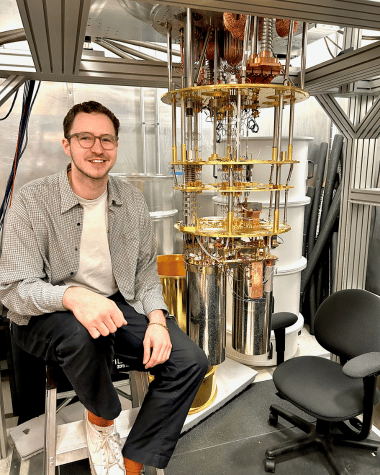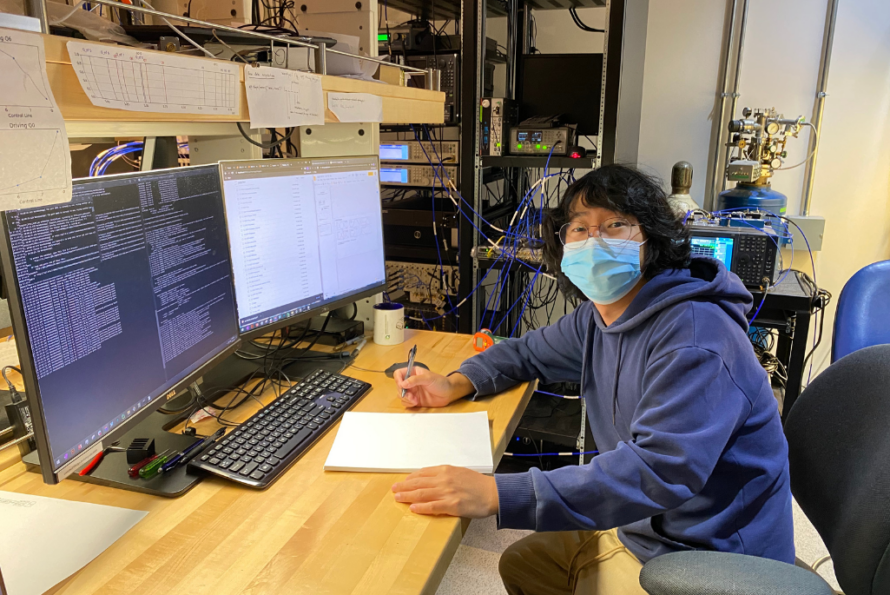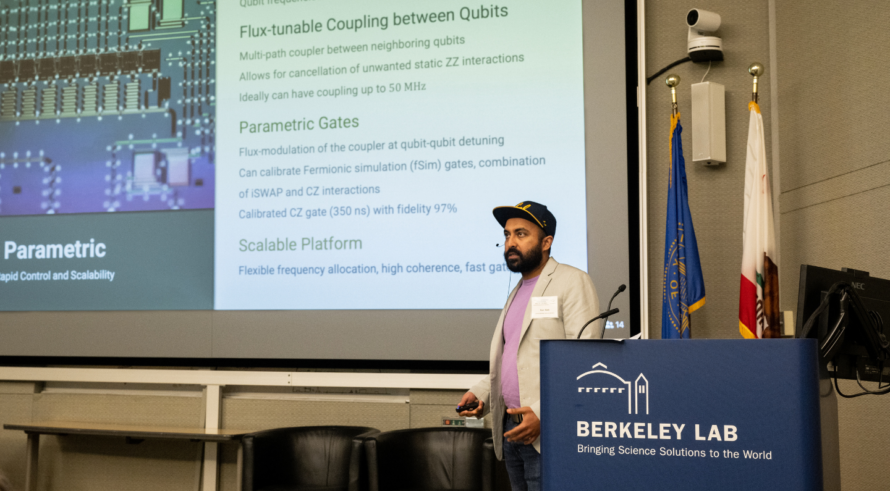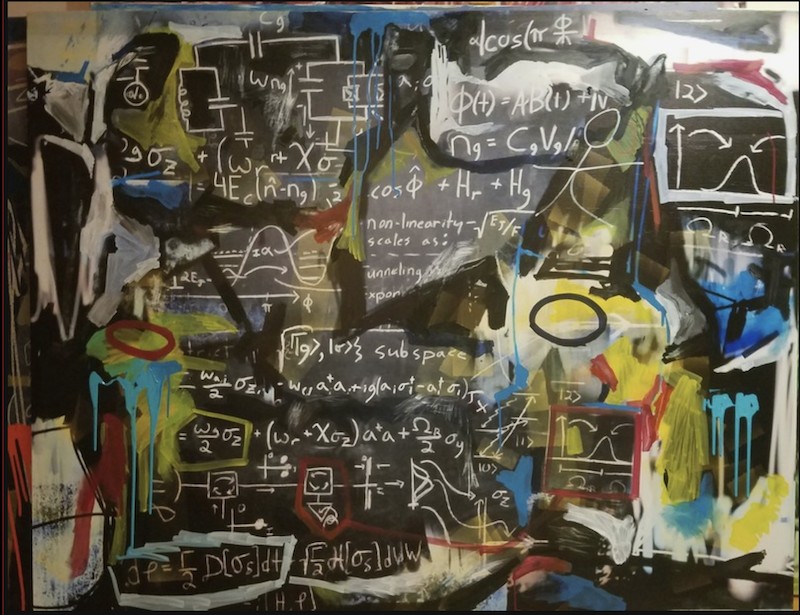This news release is also available in Spanish.

Noah Goss, a graduate student researcher at AQT and QNL, is the lead Nature paper author (Credit: Trevor Chistolini/Berkeley Lab)
An interdisciplinary team at the Advanced Quantum Testbed (AQT) at Lawrence Berkeley National Laboratory (Berkeley Lab) and the University of California, Berkeley’s Quantum Nanoelectronics Laboratory (QNL) achieved a technical breakthrough using qutrits – three-level systems – on a superconducting quantum processor. The team successfully entangled two transmon qutrits with gate fidelities significantly higher than in previously reported works, thus getting closer to enabling ternary logic that can encode more information than their binary counterparts — qubits.
Published in Nature Communications in November 2022 and featured as an editor’s highlight, this experimental success pushes forward AQT’s qutrit research and development, including previous experimental successes published in 2021 in Physical Review X and Physical Review Letters. Ternary quantum information processors offer significant potential advantages in quantum simulation and error correction, as well as the ability to improve certain quantum algorithms and applications.
Harnessing Ternary Quantum Information Processing
A superconducting qutrit, like a qubit, employs microwave-induced logical gate operations for control. However, ternary quantum logic has a more complex state space and noise environment, making single and two qutrit-logic gates in short timescales difficult to control.
Recent advances in materials science and device design have improved the coherence of superconducting devices, facilitating the control of qutrits, which are generally more susceptible to noise. To fully leverage a qutrit processor’s power, however, it’s necessary to execute operations with high control of individual qutrits, but also entangle neighboring qutrits with high-fidelity and flexible control.
Research teams have already demonstrated single qutrit operations with high fidelity. Still, entangling-gate speed has been compromised thus far by relying on a slow and static interaction that is always “on.” Speeding up this static interaction without the ability to tune it would increase the undesired noise, crosstalk, and errors in the system.
The team leading the demonstration expanded on AQT’s state-of-the-art research to implement a faster, flexible, and tunable microwave-activated entanglement between two transmon qutrits with fixed frequency and fixed coupling. This new approach to qutrit entanglement generated two universal two-qutrit gates, the controlled-Z gate (CZ) and the controlled-Z inverse gate (CZ+). Using the cycle benchmarking method from AQT’s previous qutrit work with industry collaborator, Keysight Technologies, the team measured a process fidelity for a two-qutrit entangling gate of up to 97.3%, decreasing the infidelity from previous efforts by a factor of around four. Furthermore, for the first time in the study of qutrits, AQT researchers applied and generalized another established protocol – cross-entropy benchmarking – for characterizing gate noise and determining the fidelity of gate operations.
Exploring New Frontiers in Quantum Physics
Noah Goss, a graduate student researcher at AQT and QNL, is the lead paper author. Goss is excited about advancing the understanding of quantum mechanics with qutrit gates.
“A combination of different works in AQT and QNL enabled us to get to this point, where we can characterize and understand the physics with qutrit logic gates well. We synthesized a lot of previous expertise, and took it a step further in the experiment, by introducing an interaction for qutrits with a high degree of control and which had not been studied before,” said Goss.

AQT’s team demonstrated in 2021 how to deploy a microwave-activated tunable coupling between fixed frequency qubits. To do so for qutrits, Goss and the team applied and characterized the differential AC Stark shift for two fixed frequency transmon qutrits. The AC Stark shift uses microwave light to make small changes in the transition frequencies and energy level structure of the coupled qutrit system to tune the entanglement between the two qutrits.
“We learned how to generate entanglement with two-qutrit gates without sacrificing single qutrit gates. And, if you compare the fidelity achieved in the experimental demonstration with qutrits, it’s competitive with the absolute state-of-the-art three-qubit gates, despite being on an even larger space,” said Goss.
The physics studied in this work to generate qutrit entanglement between two fixed frequency transmons can be applied to different hardware architectures, including those with tunable coupling, or different superconducting circuits such as fluxonium.
Building A Quantum-Ready Vision
Generating high-fidelity qutrit gates introduces complexity in all areas of quantum computing. AQT offers an ideal training laboratory for these types of broad, cutting-edge explorations with increasingly complex superconducting processors. AQT is also training the next generation of scientists and engineers through its research opportunities and open access to the lab’s testbed. In the third year of the testbed user program, the team’s experimental work has sparked further interest in future research collaborations.
“It’s fun and cool to keep building upon prior works while driving a direction of qutrit R&D forward, from a very different angle than many of the rest of academia and industry. AQT is a great place for such exploration. There are still so many details that need to be worked out and so much physics to do in this growing subfield of qutrits,” said Goss.
###
Founded in 1931 on the belief that the biggest scientific challenges are best addressed by teams, Lawrence Berkeley National Laboratory and its scientists have been recognized with 16 Nobel Prizes. Today, Berkeley Lab researchers develop sustainable energy and environmental solutions, create useful new materials, advance the frontiers of computing, and probe the mysteries of life, matter, and the universe. Scientists from around the world rely on the Lab’s facilities for their own discovery science. Berkeley Lab is a multiprogram national laboratory, managed by the University of California for the U.S. Department of Energy’s Office of Science.
DOE’s Office of Science is the single largest supporter of basic research in the physical sciences in the United States, and is working to address some of the most pressing challenges of our time. For more information, please visit energy.gov/science.



